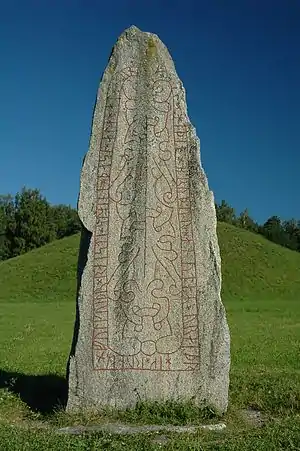
Anundshög (also Anundshögen and Anunds hög) is a tumulus near Västerås in Västmanland,[1] the largest in Sweden. It has a diameter of 60 metres (200 ft) and is about 9 metres (30 ft) high.[1]
Assessments of the era of the mound vary between the Bronze Age and the late Iron Age.[2] A fireplace under it has been dated by radiocarbon dating to sometime between AD 210 and 540.
Some historians have associated the mound with the legendary King Anund, while others regard this as speculative. It is purported also that the name is taken from the large runestone at the site, (Vs 13) the central stone in a row of 15 alongside the mound, re-erected in the 1960s and apparently marking out the route of the Eriksgata. The inscription on the runestone reads:
- + fulkuiþr + raisti + stainn + þasi + ala + at + sun + + sin + hiþin + bruþur + anutaʀ + uraiþr hik + runaʀ
- "Folkvid raised all of these stones after his son Heden, Anund's brother. Vred carved the runes."[3]
At the foot of the mound are 2 large stone ships placed end to end, 51 metres (167 ft) and 54 metres (177 ft) long.[3] The site was a thing-place and the ship settings may be associated with this function.[4]
 Stone ships
Stone ships Anundshög runestone, Vs 13
Anundshög runestone, Vs 13 Runestone and some of the line of stones marking Eriksgata
Runestone and some of the line of stones marking Eriksgata
References
- 1 2 "Anundshögen". Nationalencyklopedin (in Swedish). Retrieved 18 August 2010. (subscription required)
- ↑ Peter Bratt, "Varför förstördes Anundshögen?", Populär Arkeologi 4 (1999) (in Swedish)
- 1 2 Magnús Magnússon, Vikings!, New York: Dutton, 1980, ISBN 0-525-22892-6, p. 98.
- ↑ Vendel Period Studies: Transactions of the Boat-Grave Symposium in Stockholm, February 2–3, 1981, ed. Jan Peder Lamm and Hans-Åke Nordstrom, Statens Historiska Museum Studies 2, Stockholm: Statens Historiska Museum, 1983, ISBN 91-7192-547-3, p. 130.
External links
- Anundshög homepage
- Jouni Tervalampi, Anundshög, utanför Västerås, Västmanland (in Swedish)
- Anunds mäktiga gravhög, Vikingarnas landskap, Fotevikens Museum (in Swedish)
- Anundshögen, Runstenar i Sverige, Swedish National Heritage Board (in Swedish)